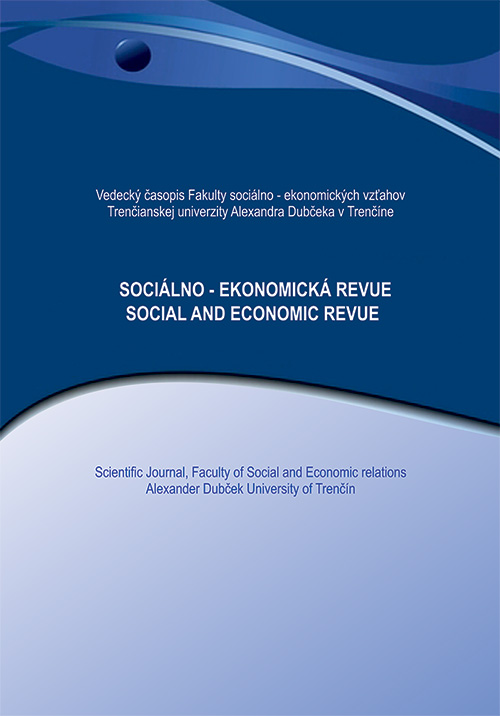MODELS OF THE WELFARE STATE IN EUROPE: GERMANY AND SWEDEN
The research subject of our work is the welfare state. The object of the research are models of the welfare state with a focus on selected countries. These countries are Germany, as a representative of the corporate model, and Sweden, as a representative of the social-democratic model. The aim of our work is based on selected models of the welfare (in Germany and Sweden) to identify social policy instruments and their current problems. Although there is no exact definition of the welfare state, in the first part of our work we will approach it with the help of definitions from several Slovak and foreign authors, which will help us to find out the current state of the researched problem. In the continuation of this part, we focus on the typology of the welfare state and concretize the typology according to G. Espring-Andersen. In the summary table, we will at least marginally present other typologies of welfare states, for example according to Leibfried, Siaroff or Bonoli. In the second part of our work, we specify the German and Swedish model, which we approach based on an analysis of the literature using data from individual ministries of the surveyed countries. In the third part, we compare the examined models of selected countries based on data on public social spending. We also arrive at the conclusions necessary to meet the goal of our work by analyzing the laws in the given area or data from the OECD.
Release: 2020/1 Pages: 18-28 JEL classification: I31, I38
DOI:
Keywords: welfare state, social policy models, social policy, liberal model, conservative - corporate model, social - democratic model
Section:
Contacts:
Ing. Andrea Horváthová
Faculty of Social and Economic Relations
Alexander Dubček University of Trenčín
Študentská 2
911 50 Trenčín
Slovak Republic
horvathova.ada@gmail.com
Ing. Jaroslav Éhn
Faculty of Social and Economic Relations
Alexander Dubček University of Trenčín
Študentská 2
911 50 Trenčín
Slovak Republic
jaroslavehn@azet.sk
Literature:
Baranowski, M. (2013). Towards the Welfare State Sociology. Retrieved from: https://www.researchgate.net/publication/259970216_Towards_the_Welfare_State_Sociology
Benda, L., Fenger M., Koster, F., Van der Veen, R. (2017). Social Investment Risks? An Explorative Analysis Of New Social Risks In The Social Investment. Statecorvinus Journal Of Sociology And Social Policy, vol. 8, no. 2, pp. 25-42., DOI:10.14267/CJSSP.2017.2.02.
Bundesministerium fur Arbeit und Soziales. (2009). Was ist Soziale Sicherung? Retrieved from: https://www.bmas.de/DE/Themen/Soziale-Sicherung/erklaerung-soziale-sicherung.html
Creapaldi Ch., Da Roit B., Castegnaro C., Pasquinelli S., Eydoux A., Gonzales E., Greve B., Mesini D., Topinska I., (2017). Minimum Income Policies in EU Member States. Retrieved from:https://www.europarl.europa.eu/RegData/etudes/STUD/2017/595365/IPOL_STU%282017%29595365_EN.pdf
Dudová, I., Stanek, V., Polonyová, S. (2018). Sociálna politika. Bratislava: Wolters Kluwer SR s. r. o., 2018. 28 s.
Eichner, T., Wagener, A. (2002). Increases in risk and welfare state. CESinfo Working Paper No. 685. Retrieved from: https://www.cesifo.org/en/publikationen/2002/working-paper/increases-risk-and-welfare-state
Emmenegger, P. (2015). Three Worlds of Welfare Capitalism: The making of a classic. Retrieved from: https://www.researchgate.net/publication/276307220_Three_Worlds_of_Welfare_Capitalism_The_making_of_a_classic
Geffert, R. (2018). Sociálna spravodlivosť a valorizačné mechanizmy starobných dôchodkov v Slovenskej republike v časovom diapazóne 2010-2018. Retrieved from: https://www.unipo.sk/public/media/30622/08_Geffert.pdf
George, S. (2015). European Welfare State in a Historical Perspective. A Critical Review. Retrieved from: https://www.researchgate.net/publication/329416200_European_Welfare_State_in_a_Historical_Perspective_A_Critical_Review
Government Offices of Sweden. (2020). Ministry of Health and Social Affairs. Retrieved from: https://www.government.se/government-of-sweden/ministry-of-health-and-social-affairs/
Hegelich, S., Meyer, H. (2008). Konflikt, Verhandlung, Sozialer Friede: Das deutsche Wohlfahrtssystem. Retrieved from j: https://link.springer.com/chapter/10.1007/978-3-531-90852-6_6
Hoffmann, R. (2005). Statement zu Fragen eines europäischen Sozialmodells. Sozialstaatskongress der IG Metall am 06.-07.04.2005. (Hoffmann 2005, 3)
Kaelble, H. (2004). Das europäische Sozialmodell – Auf dem Weg zum transnationalen Sozialstaat, WZB Jahrbuch, 2004. 36 s.
Kutsenko, O., Gorbachyk, A. (2014). Welfare state in uncertainty: disparity in social expectations and attitudes. Corvinus journal of sociology and social policy, vol. 5, no. 2, pp. 68-96., DOI: 10.14267/cjssp.2014.02.03.
Nijhuis, D. O. (2020). Business, labour and the costs of welfare state development. Journal of European Social Policy, vol. 30, no. 1, pp. 20 –33., DOI: 10.1177/0958928719855309.
OECD data. (2020). Social spending. Retrieved from: https://data.oecd.org/socialexp/social-spending.htm#indicator-chart
Pankratz, C. (2017). A Multitypological Approach to the Relationship Between Welfare States and Globalization 2017. Sage Open, vol. 7, no. 1, pp. 1-15., DOI: 10.1177/2158244017692381
Radičová, I. a kol. (1998). Sociálna politika na Slovensku. Retrieved from: https://archiv.vlada.gov.sk/old.uv/data/files/7195.pdf
Saikkonen, P., Ylikännö M. (2016). Is There Room for Targeting within Universalism? Finnish Social Assistance Recipients as Social Citizens. Social Inclusion, vol. 8, no 1, pp. 145-154., DOI:10.17645/si.v8i1.2521
Scruggs, L., James P., (2006). Welfare-state decommodification in 18 OECD countries: A replication and revision Journal of European Social Policy. Retrieved from: https://www.researchgate.net/publication/249629373_Welfare-state_decommodification_in_18_OECD_countries_A_replication_and_revision
Schuster, J. (2006). Die deutsche Diskussion über ein Europäisches Sozialmodell. Retrieved from: https://www.boeckler.de/pdf/p_arbp_116.pdf
Staněk, V. a kol. (2008) Sociálna politika. Bratislava: Sprint, 2008. 18 s
Tranow, U., Schnabel, A. (2019). Die Solidarität des Sozialstaats: Theoretische Perspektiven und empirische Fragen. Retrieved from: https://www.suz.uzh.ch/dam/jcr:b44665ca-a1f0-4d10-a456-a103975f2eda/07_Tranow%20Schnabel.pdf
Vogliotti, S., Vattai, S. (2014). Der Wohlfahrtsstaat. Retrieved from: http://afi-ipl.org/wp-content/uploads/AFI2015_Welfare_1_de.pdf
Zákon č. 189/1955. O sociálnom poistení v SRN. Retrieved from: https://www.jusline.at/gesetze/suchen?_method=POST&navigate=1&law_type_id=0&law_search_string=189%


